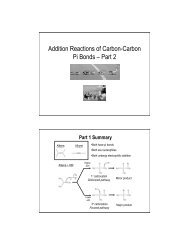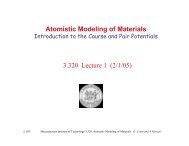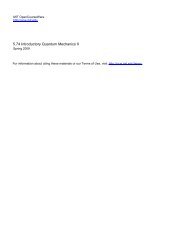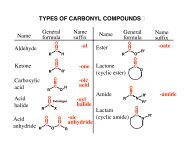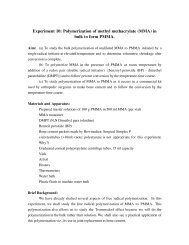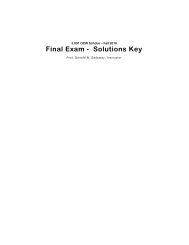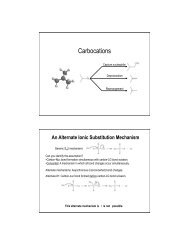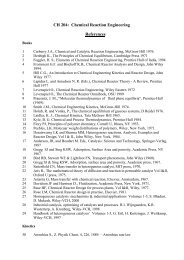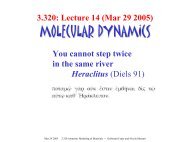Click
Click
Click
Create successful ePaper yourself
Turn your PDF publications into a flip-book with our unique Google optimized e-Paper software.
First Hour Exam 5.111<br />
Write your name below. Do not open the exam until the start of the exam is announced. The exam<br />
is closed notes and closed book.<br />
1. Read each part of each problem carefully and thoroughly.<br />
2. Read all parts of each problem. MANY OF THE LATTER PARTS OF A PROBLEM CAN BE<br />
SOLVED WITHOUT HAVING SOLVED EARLIER PARTS. However, if you need a numerical result<br />
that you were not successful in obtaining for the computation of a latter part, make a physically<br />
reasonable approximation for that quantity (and indicate it as such) and use it to solve the latter parts.<br />
3. A problem that requests you to “calculate” implies that several calculation steps may be necessary for<br />
the problem’s solution. You must show these steps clearly and indicate all values, including physical<br />
constants used to obtain your quantitative result. Significant figures must be correct.<br />
4. If you don’t understand what the problem is requesting, raise your hand and a proctor will come to<br />
your desk.<br />
5. Physical constants, formulas and a periodic table are given on the last page. You may detach this<br />
page once the exam has started.<br />
Suggested time<br />
1. 12 minutes (22 points) _____________<br />
2. 10 minutes (16 points) ______________<br />
3. 19 minutes (38 points) ______________<br />
4. 9 minutes (24 points) ______________<br />
Total (100 points)<br />
_________________<br />
Name ___________________________________
Page 2 of 10 pages<br />
1. (22 points) The photoelectric effect<br />
A beam of light with an intensity of 15 W is incident on a copper plate (φ = 7.43 x 10 -19 J). Electrons<br />
with a minimum wavelength of 3.75 x 10 -10 m are ejected from the surface of the copper.<br />
(a) (12 points) Calculate the frequency of the incident light.
Page 3 of 10 pages<br />
A beam of light with an intensity of 15 W is incident on a copper plate (φ = 7.43 x 10 -19 J). Electrons<br />
with a minimum wavelength of 3.75 x 10 -10 m are ejected from the surface of the copper.<br />
(b) (6 points) Calculate the maximum number of electrons that can be ejected by a 3.0-second pulse of<br />
the incident light.<br />
(c) (4 points) If a new light source (E i = 7.19 x 10 -19 J) with an intensity of 35 W is incident on the<br />
copper surface, what is the maximum number of electrons that can be ejected from a 6.0 second pulse of<br />
light
Page 4 of 10 pages<br />
2. (16 points) One-electron atoms:<br />
Consider a Ca 19+ ion with its electron in the 5 th excited state.<br />
(a) (12 points) Calculate the longest wavelength of light that could be emitted when the Ca 19+ electron<br />
transitions to a lower energy state. Report your answer with three significant figures.<br />
(b) (4 points) Suppose the same transition as in part (a) took place in a hydrogen atom. Would the<br />
wavelength of emission be longer than, shorter than, or the same as your answer to part (a). Very briefly<br />
explain why. (Note: This question does NOT require a calculation. Also, you do not need to use the<br />
answer to part (a) to answer this question.)
Page 5 of 10 pages<br />
3. (32 points) Multi-electron atoms<br />
(a) (16 points) An x-ray photoelectron spectroscopy experiment with an unidentified element, X,<br />
displays an emission spectrum with four distinct kinetic energies: 5.9 x 10 -17 J, 2.53 x 10 -18 J, 2.59 x 10 -<br />
20 J, and 2.67 x 10 -20 J. (Assume the incident light has sufficient energy to eject any electron in the<br />
atom.)<br />
(i) (4 points) Name all of the possible ground state atoms that could yield this spectrum.<br />
(ii) (8 points) Calculate the binding energy of an electron in the 2p orbital of element X if the x-rays<br />
used for the spectroscopy experiment had an energy of 2.68 x 10 -16 J.<br />
(iii) (4 points) Consider both the filled and unfilled orbitals of element X. Determine the number of:<br />
total nodes in a 4d orbital:<br />
angular nodes in the 2p y orbital:<br />
degenerate 5p orbitals:
Page 6 of 10 pages<br />
(b) (22 points) The first, second, and third ionization energies of phosphorus are 1011 kJ/mol, 1903<br />
kJ/mol, and 2912 kJ/mol respectively.<br />
(i) (8 points) Calculate the effective nuclear charge (Z eff ) experienced by a 3p electron in<br />
phosphorus.<br />
(ii) (4 points) Would it be expected that the minimum energy necessary to eject a 3s electron<br />
from phosphorus in a photoelectron spectroscopy experiment be larger, smaller, or the same as<br />
the 4 th ionization energy (IE 4 ) of phosphorus Briefly explain your answer.
Page 7 of 10 pages<br />
(iii) (4 points) Which experience less shielding, 3s-electrons or 3p-electrons in phosphorus Very<br />
briefly explain why.<br />
(iv) (4 points) On the plot below, graph the radial probability distribution for a phosphorus 3p<br />
orbital with a solid line. Label the r mp , and point to each node with an arrow. Label the axes, but<br />
do not include numbers or units.<br />
(v) (2 points) Is the r mp for a hydrogen 3p orbital longer or shorter than the r mp for a 3p<br />
phosphorus orbital Very briefly explain why.
Page 8 of 10 pages<br />
4. (24 points) Periodic trends and miscellaneous short answer<br />
(a) (5 points) Consider the second ionization energies (IE 2 ) for the following 3 rd row elements: Si, S,<br />
Mg, Al.<br />
(i) Which has the highest IE 2 <br />
(ii) Which has the third highest IE 2 <br />
(b) (5 points) Order the following atoms and ions in order of increasing atomic radius: Cl, Te, Te 2- , S.<br />
Note: use the < symbol for clarity.<br />
(c) (6 points) Give the electron configuration expected for the following atoms or ions. (You may use the<br />
noble gas configuration as a means to abbreviate the full configuration.)<br />
(i) Pb (Z = 82)<br />
(ii) Mo (Z = 42)<br />
(iii) Zr + (Z = 40)
Page 9 of 10 pages<br />
(d) (4 points) In one sentence (or less!), briefly explain the physical interpretation of Ψ 2 for a hydrogen<br />
atom.<br />
(e) (4 points) How many electrons in a single atom can have the following two quantum numbers: n =<br />
7, m l = -3
Page 10 of 10 pages
Page 11 of 10 pages<br />
c = 2.9979 x 10 8 m/s<br />
h = 6.6261 x 10 -34 J s<br />
N A = 6.022 x 10 23 mol -1<br />
m e = 9.1094 x 10 -31 kg<br />
a o = 5.292 x 10 -11 m<br />
1 amu = 1.66 x 10 -27 kg<br />
λ = h p<br />
R H = 2.1799 x 10 -18 J<br />
R = R H /h = 3.2898 x 10 15 Hz<br />
E= p2<br />
2m<br />
E n<br />
=− Z2 R H<br />
n 2<br />
E nl<br />
=− Z 2 eff<br />
R H<br />
n 2<br />
1W = 1 J s -1<br />
1 J = 1 kgm 2 s -2<br />
1 eV = 1.6022 x 10 -19 J<br />
for s wavefunction:<br />
RPD = 4πr 2 Ψ 2 dr<br />
for n f < n i ……<br />
v = Z2 R H<br />
⎛ 1<br />
2<br />
h n - 1 ⎞<br />
2<br />
⎝<br />
⎜<br />
f<br />
n i ⎠<br />
⎟<br />
Image by MIT OpenCourseWare.<br />
for n f > n i …..<br />
v = Z2 R H<br />
⎛ 1<br />
2<br />
h n - 1 ⎞<br />
2<br />
⎝<br />
⎜<br />
i<br />
n f ⎠<br />
⎟



